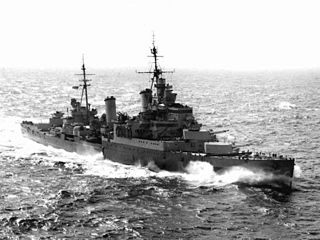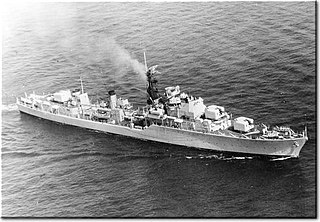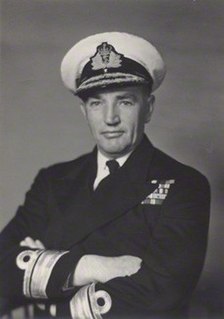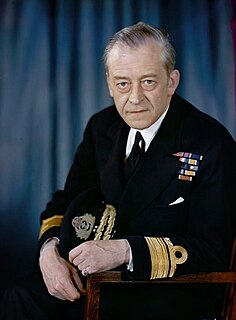Vice-Admiral Sir John Stuart Crosbie Lea, KBE (4 June 1923 - 20 May 2015) was a Royal Navy officer who went onto be Director-General, Naval Manpower and Training.
Vice-Admiral Sir John Stuart Crosbie Lea, KBE (4 June 1923 - 20 May 2015) was a Royal Navy officer who went onto be Director-General, Naval Manpower and Training.
John Stuart Crosbie Lea was born on 4 June 1923 at Simla in India where his father was serving with the Indian Army. When he was sent back to the United Kingdom for school at Boxgrove Prep in Guildford and then Shrewsbury School he spoke better Hindustani than English. [1]

Shimla, also known as Simla, is the capital and the largest city of the Indian state of Himachal Pradesh. Shimla is also a district which is bounded by the state of Uttarakhand in the south-east, districts of Mandi and Kullu in the north, Kinnaur in the east, Sirmaur in the south and Solan in the west. In 1864, Shimla was declared as the summer capital of British India, succeeding Murree, northeast of Rawalpindi. After independence, the city became the capital of Punjab and was later made the capital of Himachal Pradesh. It is the principal commercial, cultural and educational centre of the state.

India, also known as the Republic of India, is a country in South Asia. It is the seventh largest country by area and with more than 1.3 billion people, it is the second most populous country as well as the most populous democracy in the world. Bounded by the Indian Ocean on the south, the Arabian Sea on the southwest, and the Bay of Bengal on the southeast, it shares land borders with Pakistan to the west; China, Nepal, and Bhutan to the northeast; and Bangladesh and Myanmar to the east. In the Indian Ocean, India is in the vicinity of Sri Lanka and the Maldives, while its Andaman and Nicobar Islands share a maritime border with Thailand and Indonesia.

The Indian Army is the land-based branch and the largest component of Indian Armed Forces. The President of India is the Supreme Commander of the Indian Army, and it is commanded by the Chief of Army Staff (COAS), who is a four-star general. Two officers have been conferred with the rank of field marshal, a five-star rank, which is a ceremonial position of great honour. The Indian Army originated from the armies of the East India Company, which eventually became the British Indian Army, and the armies of the princely states, which finally became the national army after independence. The units and regiments of the Indian Army have diverse histories and have participated in a number of battles and campaigns across the world, earning a large number of battle and theatre honours before and after Independence.
Lea studied science, mathematics and mechanics at Sixth Form and aimed to study at the Royal Naval Engineering College in 1942. [1]

Science is a systematic enterprise that builds and organizes knowledge in the form of testable explanations and predictions about the universe.

Mathematics includes the study of such topics as quantity, structure, space, and change.
Mechanics is that area of science concerned with the behaviour of physical bodies when subjected to forces or displacements, and the subsequent effects of the bodies on their environment. The scientific discipline has its origins in Ancient Greece with the writings of Aristotle and Archimedes. During the early modern period, scientists such as Galileo, Kepler, and Newton laid the foundation for what is now known as classical mechanics. It is a branch of classical physics that deals with particles that are either at rest or are moving with velocities significantly less than the speed of light. It can also be defined as a branch of science which deals with the motion of and forces on objects. The field is yet less widely understood in terms of quantum theory.
In 1943, during his fifth term at the naval engineering college, Lea joined HMS Sheffield as part of his sea training. While aboard he stood watch on the bridge and witnessed the bombardment of German positions on the Amalfi coast. He then joined HMS Glasgow and participated in Operation Stonewall. This operation lead to the Battle of the Bay of Biscay where on 28 December 1943, in rough seas, Glasgow along with HMS Enterprise engaged German shipping. Three destroyers were sunk and a further four damaged before Glasgow was forced to break off the engagement. On returning to the college he found that although he had participated in two naval engagements he was not entitled to a campaign medal. [1]

HMS Sheffield was one of the Southampton sub class of the Town-class cruisers of the Royal Navy during the Second World War. She took part in actions against several major German warships. Unlike most Royal Navy ships of her time, her fittings were constructed from stainless steel instead of the more traditional brass. This was an attempt to reduce the amount of cleaning required on the part of the crew. Her nickname, the "Shiny Sheff", stemmed from this. A prototype radar system was placed into service in August 1938 on the Sheffield. It was the first vessel in the Royal Navy to be so equipped.

The bridge of a ship is the room or platform from which the ship can be commanded. When a ship is under way, the bridge is manned by an officer of the watch aided usually by an able seaman acting as lookout. During critical maneuvers the captain will be on the bridge, often supported by an officer of the watch, an able seaman on the wheel and sometimes a pilot, if required.
A bombardment is an attack by artillery fire or by dropping bombs from aircraft on fortifications, combatants, or towns and buildings.
After the war Lea became a submarine engineer in 1946. Across the subsequent decade he served in HMS Talent, HMS Tireless, HMS Aurochs, HMS Explorer as well as the submarine depot ship HMS Forth at Malta. [1]

A submarine is a watercraft capable of independent operation underwater. It differs from a submersible, which has more limited underwater capability. It is also sometimes used historically or colloquially to refer to remotely operated vehicles and robots, as well as medium-sized or smaller vessels, such as the midget submarine and the wet sub.

HMS Talent was a British submarine of the third group of the T class. She was built as P337(S37) by Vickers Armstrong, Barrow, and launched on 13 February 1945. She was originally to have been named HMS Tasman, but was this was changed to Talent after the previous HMS Talent was transferred to the Royal Netherlands Navy.

HMS Tireless, a Taciturn- or T-class submarine, was the first ship of the Royal Navy to bear that name. She was authorized under the 1941 War Emergency Program and her keel was laid down on 30 October 1941 at Portsmouth Dockyard. She was launched on 19 March 1943 and was completed on 18 April 1945.
Lea graduated from the Naval Staff College in 1958 then served in HMS Daring between 1959 and 1961 as squadron engineer officer. [1]

The Royal Naval College, Greenwich, was a Royal Navy training establishment between 1873 and 1998, providing courses for naval officers. It was the home of the Royal Navy's staff college, which provided advanced training for officers. The equivalent in the British Army was the Staff College, Camberley and the equivalent in the Royal Air Force was the RAF Staff College, Bracknell.

HMS Daring was the nameship of the Daring-class destroyers authorised in 1944. Between 1953 and 1957 they were reclassified as "Darings" and not included in the destroyer total, but from October 1957 they reverted to classification as destroyers. Daring was built by Swan, Hunter and Wigham Richardson on the Tyne and engined by the Wallsend Slipway & Engineering Company. She was laid down on 29 September 1945; launched on 10 August 1949; and completed on 8 March 1952. She served five commissions, was placed in reserve in December 1968 and sold for scrap in 1971. She was the sixth ship of her name in the Royal Navy.
A squadron, or naval squadron, is a significant group of warships which is nonetheless considered too small to be designated a fleet. A squadron is typically a part of a fleet. Between different navies there are no clear defining parameters to distinguish a squadron from a fleet, and the size and strength of a naval squadron varies greatly according to the country and time period. Groups of small warships, or small groups of major warships, might instead be designated flotillas by some navies according to their terminology. Since the size of a naval squadron varies greatly, the rank associated with command of a squadron also varies greatly.
In the post of marine engineer he joined the aircraft carrier HMS Centaur in 1966 before becoming deputy superintendent of the Clyde submarine base in 1967. The work entailed making the base ready for Polaris missile-firing submarines, this he did in budget and ahead of schedule. [1]
In 1974, while commodore of the Portsmouth Lea barracks, he was asked if it would be permissible to hold a Trafalgar Night dinner on 21 October. Concerned about the availability of after dinner speakers Lea suggested Pickle Night as an alternative. This was in honour of the return of HMS Pickle, a schooner carrying word of the Battle of Trafalgar. The tradition of Pickle Night dinners was born. [1]
He was appointed Director-General, Naval Manpower and Training from December 1977 to January 1980.[ citation needed ]
On his retirement he went with his wife to their home on Hayling Island. He and his wife Pat were keen gardeners and also travelled the world in support of the England cricket team. [2]

The Second Sea Lord (2SL) is one of the most senior admirals of the British Royal Navy, responsible for personnel and naval shore establishments. Originally titled Second Naval Lord in 1830, the post was restyled Second Sea Lord in 1904. He is based at Navy Command, Headquarters.
Trafalgar Day is the celebration of the victory won by the Royal Navy, commanded by Vice-Admiral Horatio Nelson, over the combined French and Spanish fleets at the Battle of Trafalgar on 21 October 1805.
Admiral Sir William Fanshawe Martin, 4th Baronet,, was a Royal Navy officer. As a commander, he provided valuable support to British merchants at Callao in Peru in the early 1820s during the Peruvian War of Independence. He became First Naval Lord in the Second Derby–Disraeli ministry in March 1858 and in that capacity acted as a strong advocate for the procurement of Britain's first ironclad warship. He went on to be Commander-in-Chief, Mediterranean Fleet and in that role provided important assistance during the Italian disturbances in 1860 and 1861, reformed the system of discipline in his fleet and developed a comprehensive system of manoeuvres for steam ships.

HMS Pickle was a topsail schooner of the Royal Navy. She was originally a civilian vessel named Sting, of six guns, that Lord Hugh Seymour purchased to use as a tender on the Jamaica station. Pickle was at the Battle of Trafalgar, and though she was too small to take part in the fighting, Pickle was the first ship to bring the news of Nelson's victory to Great Britain. She also participated in a notable single-ship action when she captured the French privateer Favorite in 1807. Pickle was wrecked in 1808, but without loss of life. In 1995 five replica Baltic packet schooners were constructed at the Grumant & Askold shipyard in Russia. One, named "Alevtina & Tuy", was in 2005 renamed "Schooner Pickle", although not a replica of HMS Pickle, to represent the 1805 vessel for the 200-year Trafalgar celebration. Retaining her adopted name, she is berthed in Hull Marina on the Humber. The vessel, owned by Historic Motor and Sail, is kept as a representation of the original Pickle and can be seen at ports throughout the East coast of England during the summer months.

Admiral of the Fleet Sir Varyl Cargill Begg was a Royal Navy officer. He fought in the Second World War as gunnery officer in a cruiser taking part in the North Atlantic convoys, the Norwegian campaign and the occupation of Iceland and then as gunnery officer in a battleship operating in the Mediterranean Fleet during the Battle of Cape Matapan. After that he commanded a destroyer during the Korean War and was Commander-in-Chief of Far East Command during the Indonesia–Malaysia confrontation. He was First Sea Lord and Chief of the Naval Staff in the late 1960s. In that role he vehemently opposed plans to introduce large new aircraft carriers and instead managed to persuade the British Government to develop the design for three small "through-deck cruisers".

Admiral of the Fleet Sir Arthur John Power was a Royal Navy officer. He took part in the First World War as a gunnery officer and saw action in the Dardanelles Campaign. During the inter-war years he commanded the gunnery school at HMS Excellent and then the aircraft carrier HMS Ark Royal. During the Second World War he played a leading role in the planning for the Allied invasion of Sicily and for the Allied invasion of Italy and then commanded the naval forces for the actual landing of V Corps at Taranto in Italy in September 1943. He went on to be Commander-in-Chief of the East Indies Fleet in the closing stages of the war and conducted naval strikes on the Imperial Japanese Army in Borneo and Malaya. After the War he became Second Sea Lord and Chief of Naval Personnel, Commander-in-Chief, Mediterranean Fleet and then Commander-in-Chief, Portsmouth.

Her Majesty's Naval Base, Devonport, is the largest naval base in Western Europe and is the sole nuclear repair and refuelling facility for the Royal Navy.
Admiral of the Fleet Sir Algernon Usborne Willis was a Royal Navy officer. He served in the First World War and saw action at the Battle of Jutland in May 1916. He also served in the Second World War as Commander-in-Chief, South Atlantic in which capacity he led actions against German and Japanese raiding ships. He continued his war service as Flag Officer commanding 3rd Battle Squadron and Second in command of the Eastern Fleet and then as Flag Officer commanding Force H, the force which covered North African Operations, the Allied invasion of Sicily in July 1943 and then the Allied invasion of Italy in September 1943. He spent the final years of the war as Commander-in-Chief, Levant, in which capacity he conducted naval operations in support of the Dodecanese Campaign, and then as Second Sea Lord, in which capacity he arranged the manpower for the campaign in the Pacific Ocean against the Imperial Japanese Navy. After the war he served as Commander-in-Chief, Mediterranean Fleet, in which role he was faced with unrest in Mandatory Palestine, before he became Commander-in-Chief, Portsmouth.
Admiral Sir Wilfrid John Wentworth Woods, was a Royal Navy officer who served in the Submarine Service in the Mediterranean.

Constantine Richard Moorsom (1792–1861) was a Vice-Admiral in the Royal Navy. He commanded HMS Fury a Hecla-class bomb vessel which saw wartime service in the Bombardment of Algiers, an attack on Barbary pirates at Algiers in HMS Fury in August, 1816. Moorsom was the son of Admiral Sir Robert Moorsom, a veteran of Trafalgar. Moorsom was on the roster of HMS Revenge, his father's ship, when it was at the Battle of Trafalgar. However records show that Constantine was actually at school at the time of the battle. Moorsom rose to be chairman of the London & North Western Railway.

Admiral of the Fleet Sir George Martin was an officer of the Royal Navy who saw service during the American War of Independence, and the French Revolutionary and Napoleonic Wars. During his long naval career he took part in several significant battles, for which he was awarded a number of honours and promotions; he commanded ships at Cape St Vincent and Cape Finisterre.
Admiral Sir Peter Geoffrey Marshall Herbert is a retired senior Royal Navy officer and former Vice-Chief of the Defence Staff.
Vice Admiral Sir John Anthony Rose Troup, was a Royal Navy officer. A submariner, he served as the last Commander-in-Chief Far East Fleet (1971).
Admiral Sir Horace Rochfort Law was Commander-in-Chief Naval Home Command.
Admiral Sir Brian Thomas Brown KCB CBE is a senior Royal Navy officer who went on to be Second Sea Lord and Chief of Naval Personnel.

Admiral of the Fleet Sir George Elvey Creasy, was a senior Royal Navy officer. After serving as a junior officer in the First World War, during which he took part in operations at Heligoland Bight in 1917, he trained as a torpedo officer.
Admiral Sir Edward Gennys Fanshawe, was a Royal Navy officer who went on to be Commander-in-Chief, Portsmouth.
Vice-Admiral Sir John Charles Young Roxburgh, was a Royal Navy officer who became Flag Officer, Plymouth.
Rear Admiral John Stuart Weale, is a Royal Navy officer who serves as Flag Officer Scotland and Northern Ireland, Assistant Chief of Naval Staff Submarines and Rear Admiral Submarines.
At the end of the Cold War in 1989 the Royal Navy structure was as follows:
| This biographical article related to the military of the United Kingdom or its predecessor states is a stub. You can help Wikipedia by expanding it. |